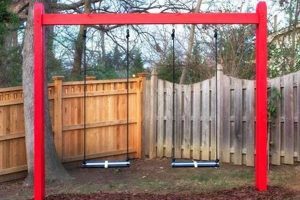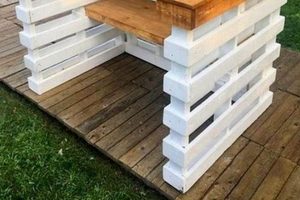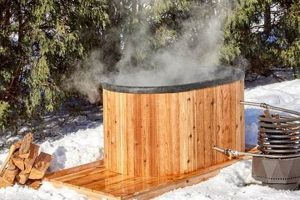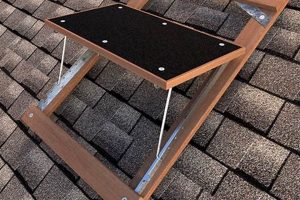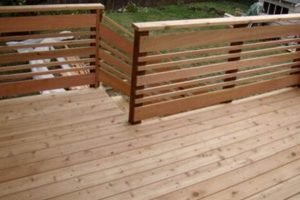Constructions created at home from lumber that serve as receptacles for growing plants are a popular gardening method. These structures, often customized in size and design, provide a contained environment for cultivating flowers, herbs, vegetables, and other flora. Examples include tiered plant holders, window boxes, and elevated garden beds, all fashioned from wood.
The practice of constructing these garden features offers numerous advantages, including cost savings, personalization opportunities, and the satisfaction of creating functional items. Historically, such projects have been a common means of increasing access to gardening for individuals with limited space or specific design preferences. This approach allows for control over soil composition and drainage, leading to healthier plant growth.
The subsequent sections will explore various design options, suitable wood types, construction techniques, and finishing methods applicable to crafting durable and aesthetically pleasing garden containers. Furthermore, safety considerations and maintenance tips will be addressed, ensuring long-lasting performance of these handcrafted horticultural elements.
Construction Tips for Wooden Plant Containers
The following guidelines aim to improve the longevity and functionality of plant containers built from wood. Adherence to these recommendations ensures structural integrity and promotes healthy plant growth.
Tip 1: Wood Selection: Prioritize naturally decay-resistant lumber such as cedar, redwood, or cypress. If using treated lumber, ensure it is approved for gardening and does not leach harmful chemicals into the soil.
Tip 2: Drainage Enhancement: Incorporate drainage holes in the base of the container to prevent waterlogging. A layer of gravel or landscape fabric at the bottom will further improve drainage and prevent soil erosion.
Tip 3: Protective Lining: Apply a waterproof membrane to the interior of the container to minimize direct contact between the soil and the wood. This barrier reduces moisture absorption and extends the lifespan of the structure.
Tip 4: Joint Reinforcement: Utilize durable fasteners, such as screws or bolts, to secure the joints. Applying waterproof wood glue to the joints prior to assembly enhances strength and water resistance.
Tip 5: Proper Sealing: Coat the exterior of the container with a sealant or stain formulated for outdoor use. This treatment provides protection against weathering and UV damage.
Tip 6: Elevate the Container: Position the container on feet or risers to allow for air circulation beneath. This prevents moisture buildup and reduces the risk of rot.
These recommendations, when implemented thoughtfully, contribute significantly to the durability and functionality of wooden plant containers, providing an optimal growing environment and extending their service life.
The subsequent sections will discuss maintenance protocols and advanced design considerations for these horticultural features.
1. Wood Type Selection
The selection of appropriate wood species is fundamental to the durability and longevity of planters crafted at home. The inherent properties of different wood types significantly influence their resistance to decay, insect infestation, and weathering, directly impacting the performance and lifespan of the finished planter.
- Decay Resistance
Certain wood species, such as cedar, redwood, and cypress, possess natural compounds that inhibit fungal growth and decay. These woods require minimal chemical treatment, reducing the risk of soil contamination and promoting a healthier growing environment. Choosing a naturally decay-resistant wood minimizes the need for frequent replacement of the planter, offering a cost-effective solution in the long term. An example is using cedar wood for a planter which will be used outside.
- Dimensional Stability
Wood types vary in their susceptibility to warping, cracking, and shrinking due to fluctuations in moisture content. Species with higher dimensional stability, like teak or ipe, maintain their shape and structural integrity over time, even under constant exposure to water and humidity. Selecting dimensionally stable wood prevents gaps and weaknesses from forming in the planter’s construction, enhancing its overall durability. Pine wood tends to warp more than cedar when exposed to the elements.
- Treatment Requirements
Some wood species require chemical treatments to enhance their resistance to decay and insects. Pressure-treated lumber is a common option, but it may contain chemicals that can leach into the soil and potentially harm plants. If using treated lumber, it is essential to select a product approved for gardening applications and line the planter with a barrier to prevent direct contact between the soil and the treated wood. Some treatments are not safe for edible plants.
- Cost Considerations
The price of different wood species varies significantly. Naturally decay-resistant woods like cedar and redwood tend to be more expensive than less durable options like pine or fir. Budget constraints may necessitate a compromise between durability and cost. However, investing in a higher-quality wood initially can save money in the long run by reducing the need for frequent repairs or replacements. Also, consider the availability in your local areas to bring the cost down.
In conclusion, the choice of wood type is a critical determinant of the performance and longevity of planters. Careful consideration of decay resistance, dimensional stability, treatment requirements, and cost is essential to selecting the most appropriate wood for any given project. The durability of a wooden planter is directly correlated to the proper wood selection.
2. Drainage Implementation
Adequate drainage is a critical factor in the construction and successful utilization of plant containers. The implementation of effective drainage systems within these structures directly impacts plant health, longevity, and the overall structural integrity of the wooden framework.
- Prevention of Root Rot
Excessive moisture accumulation within plant containers creates an anaerobic environment that promotes the growth of harmful fungi and bacteria. These pathogens attack plant roots, leading to root rot, a condition that inhibits nutrient uptake and ultimately causes plant death. Proper drainage facilitates the removal of excess water, preventing the development of these detrimental conditions and ensuring a healthy root system. An example is the use of drainage holes in the bottom of the container to release excess water after heavy rainfall.
- Aeration of Soil
Effective drainage not only removes excess water but also promotes aeration of the soil. Air spaces within the soil are essential for root respiration and the uptake of oxygen, which is necessary for various metabolic processes. Waterlogged soil lacks these air spaces, hindering root function and overall plant growth. The presence of drainage elements, such as gravel layers, allows for air circulation and maintains optimal soil aeration. Without proper drainage, plants may show signs of stunted growth or yellowing leaves.
- Control of Soil Moisture Levels
Different plant species require varying levels of soil moisture. Proper drainage enables precise control over moisture levels within the container. It prevents the soil from becoming waterlogged after irrigation or rainfall, while still retaining sufficient moisture for plant needs. This control is particularly important for plants sensitive to overwatering, such as succulents and cacti. The strategic placement of drainage holes and the selection of well-draining soil mixes contribute to effective moisture control.
- Preservation of Container Integrity
Prolonged exposure to excessive moisture can accelerate the decay of wooden containers. Waterlogged soil creates a consistently damp environment that promotes the growth of mold and fungi, leading to wood rot and structural weakening. Effective drainage minimizes moisture contact with the wood, extending the lifespan of the container and preventing costly repairs or replacements. The use of a liner in conjunction with adequate drainage further protects the wood from constant moisture exposure.
These interconnected aspects underscore the vital role of efficient drainage in homemade plant containers. Failing to address this aspect can result in diminished plant health, structural damage to the container, and ultimately, a shortened lifespan for both the plants and the planter. Implementing an appropriate drainage strategy is an investment in the long-term success of the horticultural endeavor and the durability of the crafted structure.
3. Joint Construction
The structural integrity of plant containers is fundamentally dependent on the quality of joint construction. Weak or improperly executed joints compromise the stability and longevity of the entire structure, leading to premature failure and the potential loss of plants. Joint construction refers to the methods employed to connect individual pieces of lumber to form a cohesive unit. These methods must withstand the stresses of soil weight, moisture exposure, and environmental fluctuations. Consider a planter box where simple butt joints are used without reinforcement. The weight of the soil, combined with moisture weakening the wood, can cause the joints to separate over time, leading to the collapse of the box. This illustrates the direct cause-and-effect relationship between joint quality and structural performance.
Different joint types offer varying degrees of strength and resistance to these forces. Simple joints, such as butt joints, are relatively easy to execute but provide minimal structural support. Stronger joint options, including mortise and tenon joints, dovetail joints, or the use of reinforcing elements like screws, bolts, or metal brackets, are crucial for larger or more demanding planter designs. A raised garden bed, for example, which is larger and holds more soil than a small window box, necessitates robust joint construction to prevent bowing or collapse. Moreover, the choice of adhesive, such as waterproof wood glue, significantly impacts the joint’s resistance to moisture damage. Failing to use weather-resistant adhesives can cause joints to delaminate over time, weakening the structure. Choosing the correct joint for the application is the first step to a lasting container.
In summary, understanding the principles of sound joint construction is paramount for successful creation. The selection of appropriate joint types, combined with the use of durable fasteners and adhesives, directly contributes to the structural stability, durability, and overall lifespan of the planter. Challenges in joint construction often arise from improper execution or the selection of inadequate methods for the specific design and anticipated stresses. Addressing these challenges through careful planning and meticulous execution is essential for creating plant containers that withstand the test of time and provide a suitable environment for plant growth.
4. Protective Sealing
Protective sealing is an indispensable process within the construction of plant containers, directly influencing their structural longevity and resistance to environmental degradation. The primary cause-and-effect relationship lies in the sealant’s ability to create a barrier against moisture penetration, ultraviolet (UV) radiation, and fungal growth. Without adequate sealing, wooden planters are susceptible to water absorption, leading to swelling, warping, and eventual decay. UV exposure accelerates the breakdown of the wood’s cellular structure, causing it to become brittle and prone to cracking. Fungal spores, thriving in moist environments, actively decompose the wood, compromising its integrity. Sealing mitigates these effects, extending the lifespan of the planter and preserving its aesthetic qualities. Consider a planter constructed from untreated pine, exposed to consistent rainfall and sunlight. Within a single growing season, it may exhibit signs of warping and discoloration, necessitating costly repairs or replacement. In contrast, a properly sealed planter constructed from the same material could withstand several seasons of exposure with minimal degradation.
The selection of an appropriate sealant is critical for optimal protection. Oil-based sealants offer excellent water resistance but may be susceptible to UV degradation. Water-based acrylic sealants provide superior UV protection and flexibility but may require more frequent reapplication. Spar urethane sealants combine the benefits of both, offering high water resistance and UV protection, making them a suitable choice for planters exposed to harsh conditions. Application techniques are equally important. The wood should be thoroughly cleaned and sanded prior to sealing to ensure proper adhesion. Multiple thin coats are preferable to a single thick coat, allowing for uniform coverage and preventing blistering or cracking. Sealing the interior of the planter, in addition to the exterior, is crucial for preventing moisture absorption from the soil itself. For example, lining the inside with plastic sheeting or a waterproof membrane provides an additional layer of protection against moisture exposure.
In summary, protective sealing is not merely a cosmetic enhancement but a fundamental safeguard against the detrimental effects of moisture, UV radiation, and fungal growth. Proper sealant selection and application are essential for maximizing the lifespan and performance of any planter. While the initial investment in sealing materials and labor may seem significant, it is far outweighed by the long-term cost savings associated with reduced repairs, replacements, and the preservation of structural integrity. The integration of protective sealing into the construction process reflects a commitment to quality craftsmanship and sustainable gardening practices.
5. Elevated Placement
Elevated placement, in the context of wooden plant containers, signifies positioning these structures above the ground surface, typically utilizing supporting elements such as legs, risers, or platforms. This practice directly impacts the container’s lifespan, plant health, and usability. The primary cause-and-effect relationship is the reduction of direct contact between the wood and the ground, mitigating moisture absorption and subsequent decay. Direct contact with soil or damp surfaces accelerates fungal growth and wood rot, shortening the container’s lifespan. By elevating the structure, air circulation is promoted, reducing moisture buildup and inhibiting fungal activity. For example, a planter box placed directly on a lawn will experience accelerated decay compared to an identical planter raised on feet or a platform. The practical significance lies in prolonging the container’s usability, reducing maintenance needs, and ultimately lowering replacement costs.
Beyond structural benefits, elevated placement also enhances plant health. Improved drainage results from this practice, preventing waterlogging and root rot. Additionally, it can deter certain ground-dwelling pests from accessing the plants. Ergonomic advantages are also noteworthy, as elevated planters reduce the need for excessive bending or kneeling, making gardening more accessible to individuals with mobility limitations. Commercially available elevated garden beds are designed to provide optimal working heights, promoting comfortable and sustainable gardening practices. The height of the elevation should be considered carefully based on the gardener’s individual needs. For instance, raised planters can be constructed at wheelchair-accessible heights, enabling individuals with disabilities to fully engage in gardening activities.
In summary, the practice of elevating DIY wooden plant containers offers a multifaceted approach to improving their functionality and longevity. The connection between elevated placement and extended container life, enhanced plant health, and increased user accessibility underscores its importance as a key consideration in the construction and utilization of these garden structures. Despite potentially requiring additional materials and construction effort, the long-term benefits of elevated placement outweigh the initial investment. Ignoring this aspect increases the likelihood of premature container failure and compromises the overall gardening experience.
Frequently Asked Questions about Wooden Plant Containers
The following section addresses common inquiries regarding the construction, maintenance, and selection of materials for plant containers constructed from wood. These questions aim to provide clarity and guidance for individuals undertaking such projects.
Question 1: What is the optimal wood type for constructing outdoor plant containers?
Decay-resistant lumber, such as cedar, redwood, or cypress, is recommended for outdoor applications. These species exhibit natural resistance to fungal growth and insect infestation, extending the lifespan of the structure.
Question 2: How can adequate drainage be ensured in plant containers?
Drill drainage holes in the base of the container and incorporate a layer of gravel or landscape fabric. This promotes water runoff and prevents soil saturation, safeguarding plant health.
Question 3: Is it necessary to line the interior of a wooden plant container?
Lining the interior with a waterproof membrane is advisable. This barrier minimizes direct contact between the soil and the wood, reducing moisture absorption and preventing premature decay.
Question 4: What type of fasteners should be used for assembling wooden plant containers?
Durable, corrosion-resistant fasteners, such as stainless steel screws or bolts, are recommended. These materials withstand moisture exposure and maintain joint integrity over time.
Question 5: How frequently should wooden plant containers be sealed or treated?
The frequency of sealing or treatment depends on the type of sealant used and the environmental conditions. A general recommendation is to inspect the container annually and reapply sealant every one to two years, or as needed based on visible wear.
Question 6: Can treated lumber be safely used for growing edible plants?
If using treated lumber, it is imperative to select a product specifically approved for gardening applications. Additionally, lining the container with a barrier is crucial to prevent direct contact between the treated wood and the soil, mitigating the risk of chemical leaching.
In conclusion, careful consideration of wood type, drainage, lining, fasteners, sealing, and lumber treatment is essential for constructing durable and functional plant containers. These considerations directly influence plant health and structural longevity.
The subsequent section will explore advanced design considerations and alternative materials for these horticultural structures.
Conclusion
This exploration of the construction and maintenance of “diy wooden planters” has highlighted key considerations for ensuring both structural integrity and optimal growing conditions. From the selection of appropriate wood species and the implementation of effective drainage systems to the application of protective sealants and the importance of elevated placement, each factor plays a critical role in the success of such horticultural endeavors. Proper joint construction, along with careful attention to detail throughout the building process, significantly contributes to the longevity and functionality of these handcrafted containers.
The information presented herein is intended to provide a comprehensive foundation for individuals undertaking the creation of their own garden features. Continued research and adherence to best practices will yield rewarding results. By applying the knowledge gained, one may construct durable and aesthetically pleasing structures that enhance the gardening experience for years to come. Diligence and informed decision-making remain essential for realizing the full potential of handcrafted horticultural elements.


